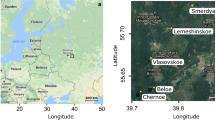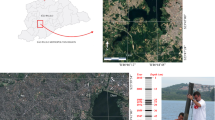Abstract
Testate amoebae are informative about palaeoecological conditions, but the methods generally used for their analyses in lake sediments differ from those used for their analyses in peats, making comparisons difficult. This study examines how filter mesh size and total number of individuals counted affect species richness, Shannon diversity, equitability, density and assemblage structure. We analysed the complete testate amoeba contents of six sediment samples from Lake Lautrey, France. The abundance of testate amoebae was high (1,403–10,870 shells cm−3), and species smaller than 63 μm in both length and width represented up to 89% of total abundance and 43% of species richness. A simulation showed that using 47- or 63-μm mesh-size filters reduced inter-sample differences and changed the patterns of abundance, species richness and assemblage structure, causing loss of information and leading to potential erroneous palaeoecological interpretation. Rarefaction analyses suggest that although 170 shells are sufficient to assess the general structure of assemblages, such small sample sizes can underestimate species richness by overlooking taxa with relative abundances <4%. Total counts of 400 shells yield better estimates of assemblage structure and recover at least 50% of total species richness, although species with absolute frequencies below 2% may still be missed. Higher counts are required to obtain reliable estimates of species richness and assemblage structure in samples that have high testate amoeba densities but are dominated by a few small taxa. Further studies should determine the bioindicator value and functional roles of small and/or rare species in lakes and thus to what extent overlooking them affects palaeoecological interpretations.








Similar content being viewed by others
References
Asioli A, Medioli FS, Patterson RT (1996) Thecamoebians as a tool for reconstruction of paleoenvironments in some Italian lakes in the foothills of the Southern Alps (Orta, Varese, and Candia). J Foraminiferal Res 26:248–263
Beyens L, Meisterfeld R (2001) Protozoa: testate amoebae. In: Smol JP, Birks HJB, Last WM (eds) Tracking environmental change using lake sediments, vol 3, Terrestrial, Algal, and Siliceous indicators. Kluwer, Dordrecht, pp 121–153
Burbidge SM, Shröder-Adams CJ (1998) Thecamoebians in Lake Winnipeg: a tool for Holocene Paleolimnology. J Paleolimnol 19:309–328
Cash J, Hopkinson J (1905) The British freshwater rhizopoda and heliozoa, vol I, Rhizopoda, Part I. London: printed for the Ray Society, 148 p
Cash J, Hopkinson J (1909) The British freshwater rhizopoda and heliozoa, vol II, Rhizopoda, Part II. London: printed for the Ray Society, 166 p
Cash J, Wailes GH, Hopkinson J (1915) The British freshwater rhizopoda and heliozoa, vol III, Rhizopoda, Part III. London: printed for the Ray Society, 156 p
Cash J, Wailes GH, Hopkinson J (1919) The British freshwater rhizopoda and heliozoa, vol IV, Rhizopoda, Part IV. London: printed for the Ray Society, 130 p
Chardez D (1967) Histoire naturelle des Protozoaires Thécamoebiens. Bruxelles: Les Naturalistes Belges, 100 p
Charman DJ (2001) Biostratigraphic and palaeoenvironmental applications of testate amoebae. Q Sci Rev 20:1753–1764
Charman DJ, Roe HM, Gehrels WR (1998) The use of testate amoebae in studies of sea-level chane: a case study from the Taf Estuary, South Wales, UK. Holocene 8:209–218
Charman DJ, Hendon D, Woodland WA (2000) The identification of testate amoebae (Protozoa: Rizopoda) in peats. QRA Technical Guide No. 9, Quaternary Research Association, London, 147 p
Charman DJ, Blundell A, ACCROTELM Members (2007) A new European testate amoebae transfer function for palaeohydrological reconstruction on ombrotrophic peatlands. J Q Sci 22:209–221
Dallimore A, Schröder-Adams CJ, Dallimore SR (2000) Holocene environmental history of thermokarst lakes on Richards Island, Northwest Territories, Canada: thecamoebians as paleolimnological indicators. J Paleolimnol 23:261–283
Ellison RL (1995) Paleolimnological analysis of Ullswater using testate amoebae. J Paleolimnol 13:51–63
Gilbert D, Mitchell EAD (2006) Microbial diversity in Sphagnum peatlands. In: Martini IP, Matinez Cortizas A, Chesworth W (eds) Peatlands: basin evolution and depository of records on global environmental and climatic changes. Elsevier, Amsterdam, pp 287–319
Gilbert D, Amblard C, Bourdier G, Francez A-J (1998) The microbial loop at the surface of a peatland: structure, function, and impact of nutrient input. Microbial Ecol 35:83–93
Gilbert D, Amblard C, Bourdier G, Francez A-J, Mitchell EAD (2000) Le régime alimentaire des Thécamoebiens (Protista, Sarcodina). Annee Biol 39:57–68
Gilbert D, Mitchell EAD, Amblard C, Bourdier G, Francez A-J (2003) Population dynamics and food preferences of the testate amoeba Nebela tincta major-bohemica-collaris complex (Protozoa) in a Sphagnum Peatland. Acta Protozool 42:99–104
Hammer Ø, Harper DAT, Ryan PD (2001) PAST: Paleontological Statistics Software Package for education and data analysis. Palaeontol Electronica 4:1–9
Heal OW (1963) The distribution of testate amoebae (Rhizopoda, testacea) in some fens and bogs in Nothern England. Zool J Linn Soc 23:254–264
Lamentowicz M, Cedro A, Gałka M, Goslar T, Miotk-Szpiganowicz G, Mitchell EAD, Pawlyta J (2008) Last millennium palaeoenvironmental changes from a Baltic bog (Poland) inferred from stable isotopes, pollen, plant macrofossils and testate amoebae. Palaeogeogr Palaeoclimatol Palaeoecol 265:93–106
Magny M, Aalbersberg G, Bégeot C, Benoit-Ruffaldi P, Bossuet G, Disnar JR, Heiri O, Laggoun-Defarge F, Mazier F, Millet L, Peyron O, Vannière B, Walter-Simonnet AV (2006) Environmental and climatic changes in the Jura mountains (eastern France) during the Lateglacial-Holocene transition: a multi-proxy record from Lake Lautrey. Q Sci Rev 25:414–445
Mast SO, Root FM (1916) Observations on amoeba feeding on rotifers, nematodes and ciliates and their bearing on the surface-tention theory. J Exp Zool 21:33–49
McCarthy FMG, Collins ES, McAndrews JH, Kerr HA, Scott DB, Medioli FS (1995) A comparison of postglacial Arcellacean (Thecamoebian) and pollen succession in Atlantic Canada, illustrating the potential of Arcellaceans for palaeoclimatic reconstruction. J Paleontol 69:980–993
Medioli FS, Scott DB (1983) Holocene Arcellacea (Thecamoebians) from eastern Canada. Cushman Foundation for Foraminiferal Res, Washington, Special Publication 21, 63 p
Medioli FS, Scott DB (1988) Lacustrine thecamoebians (mainly Arcellaceans) as potential tools for palaeolimnological interpretations. Palaeogeogr Palaeoclimatol Palaeoecol 62:361–386
Meisterfeld R (2002a) Order Arcellinida. In: Lee JJ, Leedale GF, Bradbury PC (eds) The illustrated guide to the Protozoa, 2nd edn. Society of Protozoologists, Lawrence, pp 827–860
Meisterfeld R (2002b) Testate amoebae with filopodia. In: Lee JJ, Leedale GF, Bradbury PC (eds) The illustrated guide to the Protozoa, 2nd edn. Society of Protozoologists, Lawrence, pp 1054–1084
Mitchell EAD, Payne RJ, Lamentowicz M (2007) Potential implications of differential preservation of testate amoebae shells for paleoenvironmental reconstruction in peatlands. J Paleolimnol 40:603–618
Mitchell EAD, Charman DJ, Warner BG (2008) Testate amoebae (Protozoa) in ecological and paleoecological studies of wetlands: past, present, and future. Biodivers Conserv 17:2115–2137
Nguyen-Viet H, Gilbert D, Bernard N, Mitchell EAD, Badot P-M (2004) Relationship between atmospheric pollution characterized by NO2 concentrations and testate amoebae abundance and diversity. Acta Protozool 43:233–329
Nguyen-Viet H, Bernard N, Mitchell EAD, Cortet J, Badot P-M, Gilbert D (2007) Relationship between testate amoeba (Protist) communities and atmospheric heavy metals accumulated in Barbula indica (Bryophyta) in Vietnam. Microbial Ecol 53:53–65
Nguyen-Viet H, Bernard N, Mitchell EAD, Badot P-M, Gilbert D (2008) Effect of lead pollution on testate amoebae communities living in Sphagnum fallax: an experimental study. Ecotox Environ Safe 69:130–138
Ogden CG (1983) Observations on the systematics of the genus Difflugia in Britain (Rhizopoda, Protozoa). Bull Br Mus (Natural History), Zoology series 44, 73 p
Ogden CG, Hedley RH (1980) An Atlas of Freshwater Testate Amoebae. Bull Br Mus (Natural History), Oxford University press, 222 p
Patterson RT, McKinnon KD, Scott DB, Medioli FS (1985) Arcellaceans (Thecamoebians) in small lakes of New Brunswick and Nova Scotia: modern distribution and Holocene stratigraphic changes. J Foramin Res 15:114–137
Patterson RT, Barker T, Burbidge SM (1996) Arcellaceans (Thecamoebians) as proxies of arsenic and mercury contamination in northeastern Ontario Lakes. J Foramin Res 26:172–183
Payne RJ, Mitchell EAD (2009) How many is enough? Determining optimal count totals for ecological and palaeoecological studies of testate amoebae. J Paleolimnol. doi:10.1007/s10933-008-9299-y
Reinhardt EG, Little M, Donato S, Findlay D, Krueger A, Clark C, Boyce J (2005) Arcellacean (thecamoebian) evidence of land-use change and eutrophication in Frenchman’s Bay, Pickering, Ontario. Environ Geol 47:729–739
Ruzicka E (1982) Die subfossilen Testaceen des Krottensees (Salzburg, Österreich). Limnologica 1:231–254
Schönborn W (1973) Paläolimnologische Studien an testaceen aus Bohrkernen des Latnjajaure (Abisko-Gebiet; Schwedisch-Lappland). Hydrobiologia 42:63–75
Schönborn W (1984) Studies on remains of Testacea in cores of the Great Woryty Lake (N.E.Poland). Limnologica 16:185–190
Scott DB, Medioli FS (1983) Agglutinated Rhizopods in Lake Erie: modern distribution and stratigraphic implications. J Paleontology 57:809–820
R Development Core Team (2007) R: a language and environment for statistical computing. R Foundation for Statistical Computing, Vienna, URL <http://www.R-project.org>
Tolonen K (1986) Rhizopod analysis. In: Berglund BE (ed) Handbook of holocene palaeoecology and palaeohydrology. Wiley, Chichester, pp 645–666
Torigai K, Schröder-Adams CJ, Burbidge SM (2000) A variable lacustrine environment in Lake Winnipeg, Manitoba: Evidence from modern thecamoebian distribution. J Paleolimnol 23:305–318
Utermöhl H (1958) Zur Vervollkommnung der quantativen Phytoplankton-Methodik. Mitt int Ver theor angew Limnol 9:1–38
Warner BG (ed) (1990) Methods in quaternary ecology. Geosci Can Reprint Series 5, 170 p
Acknowledgments
Funding to EM by Swiss NSF project no. 205321-109709/1 and CCES projects RECORD and BigLink is kindly acknowledged. The region of Franche-Comté and the French CNRS are also thanked for their financial participation. The authors thank two anonymous referees and Thomas J. Whitmore for their helpful comments on the manuscript.
Author information
Authors and Affiliations
Corresponding author
Rights and permissions
About this article
Cite this article
Wall, A.A.J., Gilbert, D., Magny, M. et al. Testate amoeba analysis of lake sediments: impact of filter size and total count on estimates of density, species richness and assemblage structure. J Paleolimnol 43, 689–704 (2010). https://doi.org/10.1007/s10933-009-9360-5
Received:
Accepted:
Published:
Issue Date:
DOI: https://doi.org/10.1007/s10933-009-9360-5




